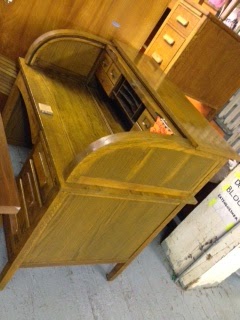Definition
noun
uk /ˌrəʊl.tɒpˈdesk/
us /ˌroʊl.tɑːp-/ ("English Definition of 'Rolltop Desk'")
"a writing desk with a sliding cover often of parallel slats fastened to a flexible backing" ("Definition of "ROLLTOP DESK").
(Photo courtesy of http://www.officemuseum.com/desks.htm)
A Short History
In the late 19th and early 20th centuries, the roll-top desk was a popular choice for small to medium-sized offices. It was mass-produced back then since the rolling wooden slats could be cranked out quickly and easily. "A place for everything, and everything in its place" was the slogan going around in the 19th century that caught everybody's attention. People were awestruck by the "idea of a double-pedestal desk, each pedestal with a bank of drawers, topped with a superstructure of drawers, pencil slides and pigeon holes for all manner of paraphernalia, plus the ability to work at one's desk then hide away the mess with the pull-down of the tambour" (Auton).
The French first introduced the roll-top desk to Britain in the early 1800s. It came as a result of Louis XV asking his cabinet maker, Jean-François Oeben, "to create a desk for him for his new palace in Versailles. Oeben set about a design that would take him the last three years of his life--and was finally finished by his successor Jean-Henri Reisener some six years later" (Auton). In total, the desk was built from 1760 to 1769 ("Antique Office Desks").
(Portrait of Louis XV of France, courtesy of http://upload.wikimedia.org/wikipedia/commons/7/78/Louis_XV_France_by_Louis-Michel_van_Loo_002.jpg)
Louis XV was not only concerned about looks, but also about security. According to Auton, both Oeben and Reisener spent a large amount of time making sure the rolling top and mechanical locking devices were no less than thief-proof.
By the late 19th century, many European furniture-builders had immigrated to America and brought their interest of roll-top desks with them. While money was flowing in the US and investors were looking to these desks, designers had to figure out a cheap way of making them. In England, the desks were so expensive that only the rich could afford them because they were handmade. But once designers figured out how to mass-produce them, roll-top desks were being churned out left and right. This went on until much later, probably until the 1960s, when more convenient and less expensive desks took over. The earliest known use of the word, "roll-top desk", is in 1880 and comes from the following bill. This same bill also contains the oldest known illustration of it.
(Photos courtesy of http://www.officemuseum.com/desks.htm. Circles placed by us.)
Difference Between a Cylinder Desk, a Tambour Desk, and
a Roll-top Desk
- Cylinder desks have an inflexible cover that is pulled down on a track shaped into a circular arc. These were difficult to use at times because one thin piece of wood had to fit perfectly in the grooves on the track. Once it was worn or had been through humidity enough, the wood would bend, warp and stick.

(Photo courtesy of http://www.officemuseum.com/desks.htm)
- Tambour desks have desktop drawers, cubbies, and pigeonholes that are covered by small wooden shutters that open and shut on the left and right. Tambour is the definition of wooden slats placed on flexible material, hence the name.
- Roll-top desks (also known as curtain desks) are essentially a marriage of the two. The wooden shutters go top to bottom like a cylindrical desk and the cylindrical desk's curved wooden cover is made into a wooden shutter instead. The one thing it has from both of them though are the pockets and pigeonholes.
(Photo courtesy of http://thumbs4.ebaystatic.com/d/l225/m/ml20VAjLGyCNrjVTX671gLw.jpg)
What We Have
(Antique Roll-Top Desk for sale for only $399.99)
(Antique Roll-Top Desk for sale for only $499.99)
(Antique Roll-Top Desk for sale for only $349.99)
It is simple to care for your newest addition. Just follow these simple guidelines:
- When cleaning your desk, stay away from harsh chemical cleaning solutions and waxes, especially if it's an antique.
- Dust it weekly with a flannel cloth, feather duster, or Swiffer duster to keep dirt from building up.
- When cleaning, give extra love to the horizontal spaces between the slats on the tambour (the rolling piece of the desk) and to the grooves of where it comes out. If you don't do this, you could get build-up in the grooves, which will make opening and closing the tambour difficult.
- If the tambour is sticking to the grooves, try rubbing a wax candle along them.
- Occasionally polish your desk to give it a nice shine. (Harbour)
If you're interested in any of our pristine antique roll-top desks, go ahead and give our Used Furniture Department a call at 503.232.7412 and/or come on by! These desks are just a tip of the iceberg of what we have at City Liquidators. Have a great day all!
Works Cited
- "Antique Office Desks." Early Office Museum. The Early Office Museum, n.d. Web. 25 Jan. 2015. <http://www.officemuseum.com/desks.htm>.
- Auton, Garry. "The Roll Top Desk." Antiques & Art in New South Wales (2006): n. pag. Desks of Distinction. 9 Sept. 2006. Web. 25 Jan. 2015. <http://www.desksofdistinction.com.au/Garry%27s%20Articles/RollTopArticle.pdf>.
- "Definition of ROLLTOP DESK." Merriam-Webster. Merriam-Webster, Incorporated, 2015. Web. 21 Jan. 2015. <http%253A%252F%252Fwww.merriam-webster.com%252Fdictionary%252Frolltop%252520desk>.
- "English Definition of "Rolltop Desk"" Cambridge Dictionaries Online. Cambridge University Press, 2015. Web. 21 Jan. 2015. <http://dictionary.cambridge.org/us/dictionary/british/rolltop-desk>.
- Harbour, Sarita. "What You Need to Know About Buying a Roll Top Desk." HubPages. HubPages Inc., 20 July 2014. Web. 25 Jan. 2015. <http://avamum.hubpages.com/hub/The-Definitive-Guide-to-Roll-Top-Desks>.
- Kelly. "The History of the Roll Top Desk." Everything Simple | Interior Design Inspiration and Home Decor. Everything Simple | Interior Design Inspiration and Home Decor, n.d. Web. 25 Jan. 2015. <http://www.everythingsimple.com/58/the-history-of-the-roll-top-desk/>.
- "Tambour Desk." Wikipedia. Wikimedia Foundation, n.d. Web. 25 Jan. 2015. <http://en.wikipedia.org/wiki/Tambour_desk>.











No comments:
Post a Comment